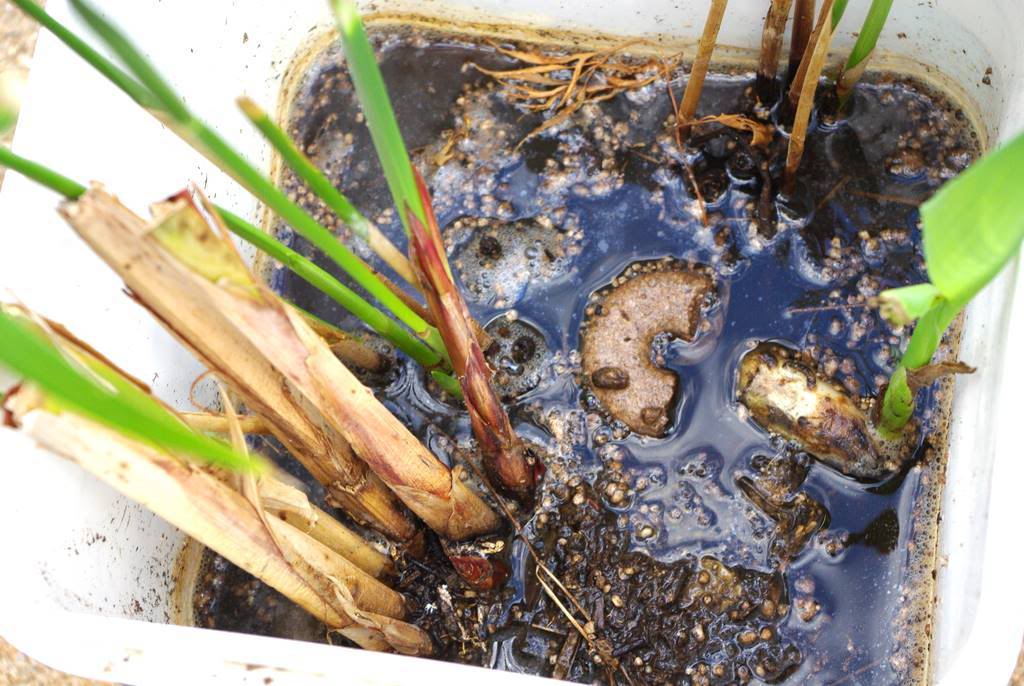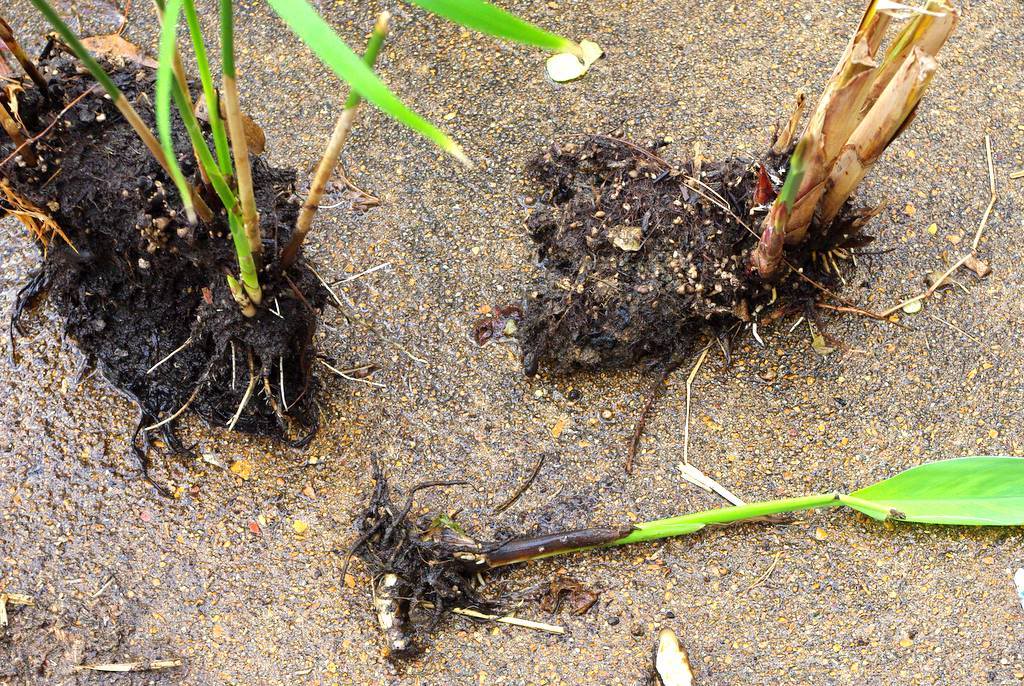Even though I've only recently completed my pond and haven't done any planting around or in it, I already have several water or bog plants. In fact I've had water plants for a few years, growing them in pots or in the ground -- most water plants do fine in regular garden soil as long as they get enough water. The problem is that most of the water plants I have are not cold-hardy enough to survive our winters, so I need to overwinter them in the garage or the house.
The large plants like various elephant ears (the ones that I either have just a single plant of, or that don't form a good bulb) and papyrus will spend the winter in the garage in a semi-dormant state where they won't form any new growth, but won't die or go completely dormant either. Some plants though I want to actively grow over the winter, either because I'm not sure yet how they'll do in the garage (with low light and temps that bottom out around 40ºF/4ºC), or because I want to have extra plants in the spring. Today's post is about these plants that will stay in the house, actively growing under lights all winter.
A few weeks back when our first freeze was about to hit, I pulled some of these plants out of the ground or pots and put them into a small bucket of water with some soil, and for the first couple of weeks was able to leave them outdoors, bringing them into the garage whenever a below-freezing night was expected. Then it got to the point where they had to come in full-time, and I put them on the floor next to my indoor plant table where they'd get a fair amount of light.
The problem with soil that stays waterlogged for too long is that it quickly turns smelly. Anaerobic bacteria form in the oxygen-deprived soils, producing that stagnant water smell that is not great to have in the house (Yankee Candle sells many different crazy scents, but "rotten pond water" isn't one of them for a reason).
That's what my bucket was starting to smell like, so it was time to take action. (That's half of a mosquito dunk in the water, not part of my breakfast donut. I'd never drop a donut.)
I pulled the plants out so I could remove as much soil as possible:
I've got a small papyrus division (upper right), a very small Canna 'Paton' division (bottom) that I want to watch grow and multiply over the winter, and a plant I rescued from the compost pile at Needmore Bamboo when I visited a couple months ago which I think is Cyperus involucratus (Umbrella plant, Umbrella palm, etc.) Even though the Umbrella palm was sitting bare and dry on the ground for a week before I saved it, it revived after I put it in some water -- that's the kind of tough plant I love!
These bubbles on the surface of the water are methane I believe:
(Besides being smelly, methane is 25 times more potent as a greenhouse gas as carbon dioxide is.)
I dumped out the waterlogged soil, hosed the loose soil from all of the roots, and took a look:
You can see the new roots (they're white), and that there is a lot of dead, brown rootmass here. All of that dead organic matter may eventually rot in the water, leading again to a smelly bucket in the house, so I removed as much of it as I felt comfortable doing:
Then it was back into the bucket, with a few inches of clean gravel (well, at least cleaner than the soil that was in the bucket before):
The gravel will give the roots something to grab onto, and also looks much nicer than muddy soil.
I then filled with clean water, adding some dechlorination drops and a little bit of Miracle-gro powder fertilizer (which gives the water that blue-gray color):
I've not used gravel before, but it should work fine, at least for the few months it will take to get these plants through the winter. I'll add more fertilizer once in a while, and will let you know how these are doing throughout the next few months. I've done about all I can to prevent smelly water, but if it still becomes a problem I can use an aquarium air pump with an airstone to oxygenate the water. I'm hoping I won't have to make that effort though.
I tackle the papyrus in tomorrow's post. The small division I have in this bucket indoors is just for fun, so I can watch it grow over the winter -- the big plants are still in my garage, waiting for me to do something with them. This small division is also a bit of an experiment, as it was taken from a plant that was in the ground and was "killed" by the freezes. Although the stems of the plant were fried I hoped that the crown of the plant (and roots) were still alive, and I was right -- this small division is growing again now.
Anyway, more on papyrus tomorrow.
.








Don't have a pond but did have an umbrella plant on a window sill for many years.
ReplyDeleteDidn't know about smelly water and methane. Do know it's loved by bitey insects - another reason to avoid it.
I get dizzy reading about all the overwintering you do! I am overwintering 2 plants - the most ever and that's plenty - my elephant ear and a fig tree.
ReplyDeleteAnne: Two reasons I overwinter so many plants: 1) I love watching them grow during the winter 2) I HATE rebuying plants each spring.
ReplyDeleteI can understand watching plants grow indoors. For me, (except for my 2 stowaways)if a plant can't stay in the ground over the winter, you won't find it in my gardens. I know what you mean about rebuying the same plant every year - I did it a few times with delphinium and flax but then it got annoying and I stopped. But new plants that are right for my zone? Can't buy too many!
ReplyDeleteoh my god, its anaerobic zone ? , and smelly like rotten egg and make sulfur dioxide ? how to avoid that ?
ReplyDeleteThank you. This is my first year with king tuts and baby tuts. I've been looking for info on how to winter them and this has help a great deal
ReplyDelete